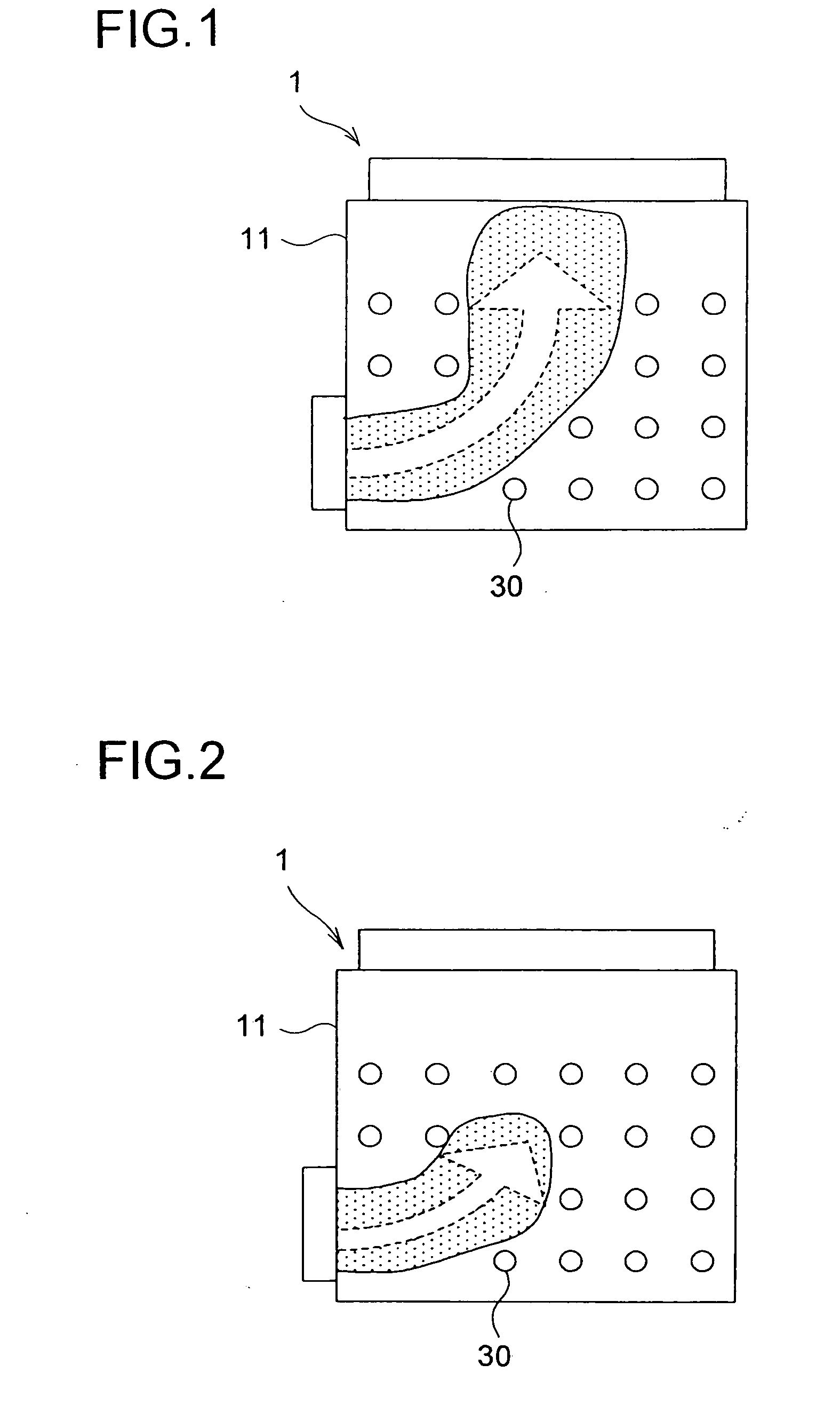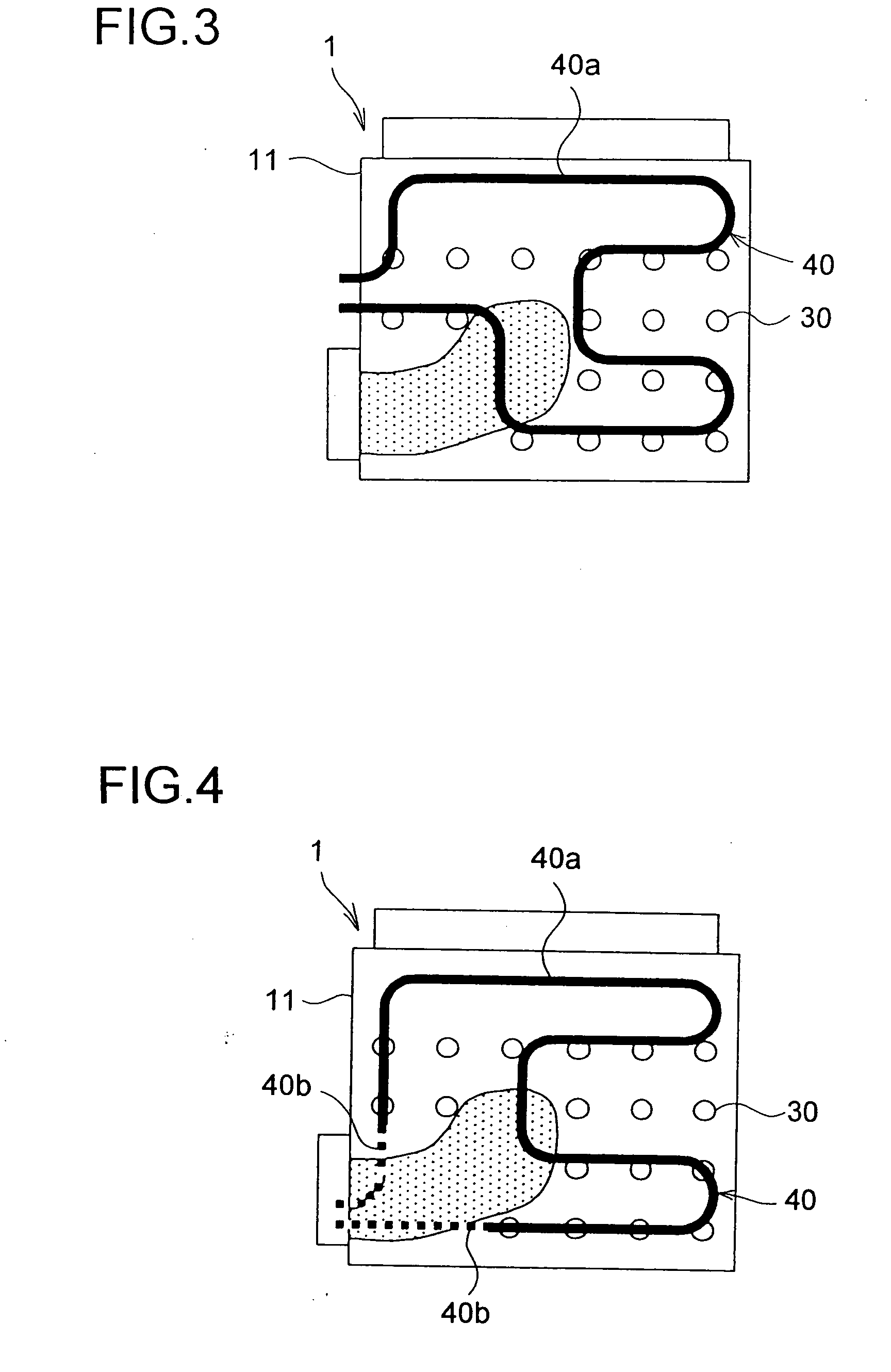Heating cooking device
a cooking device and heat sink technology, applied in the field of cooking ovens, can solve the problems of uneven cooking of foods, difficult to transmit a sufficient amount of heat to the bottom face of foods, and inability to heat foods evenly, etc., to achieve the effect of reducing the cost of the heater, reducing the shape of the heater, and alleviating uneven heating of foods
- Summary
- Abstract
- Description
- Claims
- Application Information
AI Technical Summary
Benefits of technology
Problems solved by technology
Method used
Image
Examples
first embodiment
[0062] In the cooking oven 1 of the first embodiment, the arrangement is such that the air stream that blows out from the upper blowout port 30 does not deflect downward the air stream that blows from the side blowout port 31 to the foods 60. It should be understood that the expression “not deflect” used here does not solely mean “no deflection at all” but encompasses “a small degree of deflection.”
[0063] To prevent the air stream that blows from the side blowout port 31 to the foods 60 from being deflected downward, the following construction is adopted. The openness (the proportion of the area of the open portion) of the upper blowout port 30 formed in the ceiling wall 12 is made smaller in the portion thereof from which the air stream blows out toward the air stream that blows from the side blowout port 31 to the foods 60 than in the other portion thereof.
[0064] The difference in the openness of the upper blowout port 30 is produced by varying the distribution of the perforation...
second embodiment
[0078] Specifically, as in the second embodiment, the distribution of the perforations of the upper blowout port 30 is made sparser (including “no perforations at all”) in the portion thereof from which the air stream blows out toward the air stream that flows from the side blowout port 31 to the foods 60. The upper heater 40 is realized with a linear heater such as a Nichrome wire or a sheath heater. This linear heater is so laid as to avoid where the distribution of the perforations is sparser.
[0079] In this construction, the upper heater 40 generates a smaller amount of heat where the openness of the upper blowout port 30 is smaller. This helps avoid unnecessarily heating the air present in areas where no air stream passes. On the other hand, the heat generated by the upper heater 40 concentrates where the openness of the upper blowout port 30 is greater. This ensures efficient heating of air.
[0080] Practical methods for varying the amount of heat generated by the upper heater 4...
third embodiment
[0084] In the cooking oven 1 of the third embodiment, part 40a of the upper heater 40 is arranged on the upstream side, with respect to the stream of the hot air stream, of the region where the upper blowout port 30 is arranged. With this construction, the air heated by that part 40a of the upper heater 40 blows out from every perforation of the upper blowout port 30. This helps make uniform the temperature of the hot air that blows out from every perforation of the upper blowout port 30.
[0085]FIG. 4 shows a fourth embodiment of a cooking oven according to the invention. Also in the cooking oven 1 of the fourth embodiment, the upper heater 40 is so constructed as to generate a smaller amount of heat in the portion thereof located where the openness of the upper blowout port 30 is smaller than in the portion thereof located where the openness of the upper blowout port 30 is greater. This is achieved as follows. Here, as in the third embodiment, the openness of the upper blowout port ...
PUM
 Login to View More
Login to View More Abstract
Description
Claims
Application Information
 Login to View More
Login to View More - R&D
- Intellectual Property
- Life Sciences
- Materials
- Tech Scout
- Unparalleled Data Quality
- Higher Quality Content
- 60% Fewer Hallucinations
Browse by: Latest US Patents, China's latest patents, Technical Efficacy Thesaurus, Application Domain, Technology Topic, Popular Technical Reports.
© 2025 PatSnap. All rights reserved.Legal|Privacy policy|Modern Slavery Act Transparency Statement|Sitemap|About US| Contact US: help@patsnap.com



